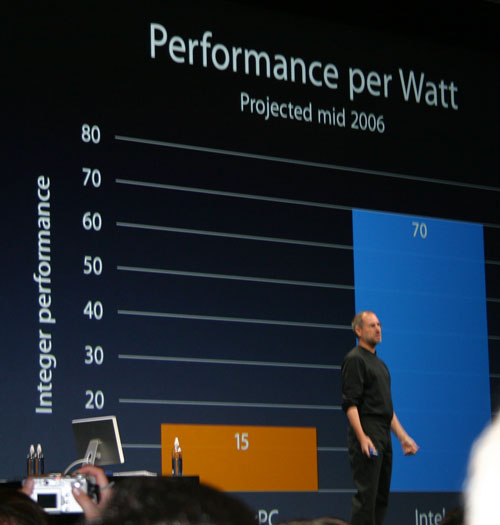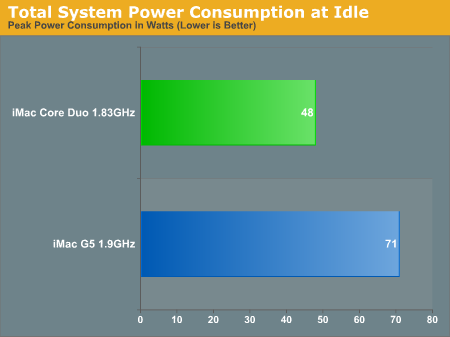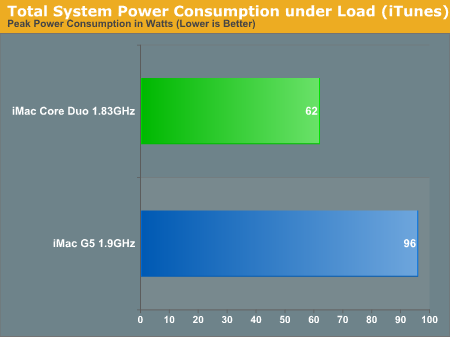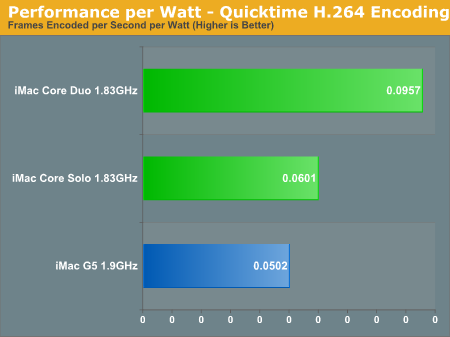Apple Makes the Switch: iMac G5 vs. iMac Core Duo
by Anand Lal Shimpi on January 30, 2006 11:26 PM EST- Posted in
- Mac
IBM vs. Intel - Performance per Watt
At Steve Jobs' WWDC 2005 Keynote, he presented this slide to the curious crowd:
While we can't test future IBM and Intel CPUs, we can definitely compare power consumption and performance per watt today and find out if Intel can at least start delivering on Apple's claims.
I started out by looking at power consumption of the iMac systems as a whole, measured at the power outlet in Watts. The systems are configured as close to identical as possible; although the Core Duo iMac has a slight advantage in its 90nm X1600 GPU compared to the iMac G5's 0.13-micron X600 GPU, I didn't focus on any GPU intensive tests so the difference should be minimized. There are obvious memory differences as well. While both systems have 512MB of memory, the Intel system uses DDR2-667 and the G5 system uses DDR2-533. Then there are the CPU and chipset differences, but those are the ones that we want to measure anyways, so they have to be there.
The first comparison is system power consumption at idle. This is with both identically configured systems being freshly booted and sitting on the desktop with no disk accesses or anything. Note that the systems weren't left alone long enough for the hard drive to spin down yet:
I also looked at power consumption during my H.264 encode test, which produced results similar to the iTunes encoding test above:
But now let's look at performance per watt and see where we stand today. I took the Quicktime H.264 encode time and converted it into frames encoded per second, then divided that by the peak power consumption values for the entire system. Note that during the Quicktime and iTunes encoding tests, the peak power consumption value and the average power consumption of the system are basically identical, since the CPU remains at close to 100% utilization for the entire duration of the test.
The end result is this graph of Frames per Second/Watt:
We are only talking about system power usage here, so if we were to truly isolate just the CPU power, the difference should be even larger, assuming that the rest of the systems consume a relatively equal amount of power in both configurations. You should also keep in mind that the Quicktime encode test is actually one of the Core Duo's weakest tests, so the actual performance per watt advantage may be even higher in tests where the Core Duo has a larger performance advantage over the G5. This is just a good test to show power consumption, since it is fairly CPU bound and consistent in its CPU load.
At Steve Jobs' WWDC 2005 Keynote, he presented this slide to the curious crowd:

While we can't test future IBM and Intel CPUs, we can definitely compare power consumption and performance per watt today and find out if Intel can at least start delivering on Apple's claims.
I started out by looking at power consumption of the iMac systems as a whole, measured at the power outlet in Watts. The systems are configured as close to identical as possible; although the Core Duo iMac has a slight advantage in its 90nm X1600 GPU compared to the iMac G5's 0.13-micron X600 GPU, I didn't focus on any GPU intensive tests so the difference should be minimized. There are obvious memory differences as well. While both systems have 512MB of memory, the Intel system uses DDR2-667 and the G5 system uses DDR2-533. Then there are the CPU and chipset differences, but those are the ones that we want to measure anyways, so they have to be there.
The first comparison is system power consumption at idle. This is with both identically configured systems being freshly booted and sitting on the desktop with no disk accesses or anything. Note that the systems weren't left alone long enough for the hard drive to spin down yet:


I also looked at power consumption during my H.264 encode test, which produced results similar to the iTunes encoding test above:

The iMac Core Solo 1.83GHz was simulated by disabling one of the Core Duo's cores
But now let's look at performance per watt and see where we stand today. I took the Quicktime H.264 encode time and converted it into frames encoded per second, then divided that by the peak power consumption values for the entire system. Note that during the Quicktime and iTunes encoding tests, the peak power consumption value and the average power consumption of the system are basically identical, since the CPU remains at close to 100% utilization for the entire duration of the test.
The end result is this graph of Frames per Second/Watt:

The iMac Core Solo 1.83GHz was simulated by disabling one of the Core Duo's cores
We are only talking about system power usage here, so if we were to truly isolate just the CPU power, the difference should be even larger, assuming that the rest of the systems consume a relatively equal amount of power in both configurations. You should also keep in mind that the Quicktime encode test is actually one of the Core Duo's weakest tests, so the actual performance per watt advantage may be even higher in tests where the Core Duo has a larger performance advantage over the G5. This is just a good test to show power consumption, since it is fairly CPU bound and consistent in its CPU load.










35 Comments
View All Comments
snookie - Friday, February 3, 2006 - link
The article is very good but surprisingly makes the same mistake as so many other reviews which is to test with only 512MB of ram. The intel imac is a much better machine with more ram and it doesn't make sense to test it with the minimum amount. Also Universal apps are coming fast and furious on a daily basis. I've got 1.5 GB of ram in mine and lots of the little apps I use everyday are already UB and are nice and fast as is the OS and iLife apps. It won't be long before Windows runs on these as well as Linux with Red Hat promising support. Check out Bare Feats for some pretty nice benchmarks including games. Yes, Quake 4 will actually run at a decent speed as well as COD 2.http://www.barefeats.com/imcd.html">http://www.barefeats.com/imcd.html
csoto - Friday, February 3, 2006 - link
Your only complaints stem from poor choice of models/configuraitons. The 20" unit will provide the added resolution, and BTO options allow up to 2GB on the Core Duo and 2.5GB on the G5 (although a 2GB soDIMM is listed at >$1K!). This is like me complaining that my mini van doesn't have a navigation system, because I was too cheap to buy the model that came with it :)Also, your assertion that the Core Duo is a "public beta" is absurd. You had zero problems running applications. Word from those around me that are testing Core Duos is that for most applications, you don't even notice Rosetta. Pro Apps users would complain, but they're never early adopters, because their apps always lag at least a few months behind the latest platform (remember the "multiprocessor plug-in" that allowed Photoshop to limp along for so long before a "MP-native" version was released?). This is a solid platform transition, likely exceeding the fairly solid (albeit far more daunting for the day) transition from 680x0 to PPC.
Now if only VMWare would ship Workstation for Mac OS X, then I could ditch the Dell...
Charles
Furen - Sunday, February 5, 2006 - link
He says he already had an iMac so in order to compare the two I'm guessing he bought the closest-matching one possible. I would hardly do to have an 20" iMac compared with a 17" one in power consumption or running at a different native resolution. I do agree that the RAM limits the system insanely but he went for default specs rather you start improving all the draw backs each system has.The reason why he says this is like a public beta is not because Rosetta sucks or anything of the sort but because there are almost no universal binaries besides those shipped by Apple. Apple chose to bring these systems forwards (at first they had said the systems would come out mid '06, I believe) without having enough of a software base and that's a pretty big drawback.
jepapac - Wednesday, February 1, 2006 - link
I was just wondering if the graphics adapter on the iMac is upgradeable since it is using pciexpress. Does anyone know?aliasfox - Thursday, February 2, 2006 - link
I'm guessing its actually the laptop X1600 in the iMac, soldered onto the motherboard. Unfortunate, yes, but given the primary audience that the iMac is targeted at, I'm not surprised.Your average home user would rather buy a new $600-1000 box instead of dropping ~$500 for more RAM, a bigger hard drive, new graphics, and a faster processor.
Eug - Thursday, February 2, 2006 - link
Why? Previous iMacs used desktop GPU parts.
aliasfox - Thursday, February 2, 2006 - link
I read somewhere that the 9600 in the second generation iMac G5 was a laptop part, and I therefore assumed that since Apple used the same GPUs in the iMac that it used in PowerBooks (GeForce FX5200, Radeon 9600, X1600), it was sourcing the same parts for both lines.Also, I've never read about an integrated 9600 or FX5200 as a desktop part. I might be mistaken though.
nizzki - Tuesday, January 31, 2006 - link
Any idea which compilers apple has used for their apps? For example, for the PPC apps I assume apple uses the IBM compiler heavily optimized for PPC instead of GCC.If that is the case, with the intel compiler for osx is in beta, the current somewhat lackluster performance of the core duo might be skewed in PPC's favor. This would be further exacerbated if Apple used GCC to compile the macintel apps, since it is unlikely to be heavily optimized for the core duo architecture.
Commodus - Tuesday, January 31, 2006 - link
Just a heads-up, Anand: the Core Duo iMac is the first iMac model to support desktop spanning, not just mirroring. So if you want, you can hook up even a 23" Cinema Display and get a huge amount of extra workspace. I'd probably only do that with a 20" iMac and the 256 MB video memory option, though.ingoldsby - Tuesday, January 31, 2006 - link
Perhaps it's just me, but the non native apps I run seem to run at about the same speed as they natively ran on my G5. While the universal binaries run much faster.I would love to see this comparison revisited with a realistic amount of memory in the machine (ie. 1gb+) instead of limiting the machine to 512mb.